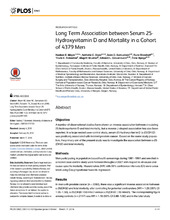| dc.contributor.author | Meyer, Haakon E | en_US |
| dc.contributor.author | Støer, Nathalie | en_US |
| dc.contributor.author | Samuelsen, Sven Ove | en_US |
| dc.contributor.author | Blomhoff, Rune | en_US |
| dc.contributor.author | Robsahm, Trude Eid | en_US |
| dc.contributor.author | Brustad, Magritt | en_US |
| dc.contributor.author | Giovannucci, Edward L | en_US |
| dc.contributor.author | Bjørge, Tone | en_US |
| dc.date.accessioned | 2016-09-30T07:48:37Z | |
| dc.date.available | 2016-09-30T07:48:37Z | |
| dc.date.issued | 2016-03-17 | |
| dc.Published | PLoS ONE 2016, 11(3) | eng |
| dc.identifier.issn | 1932-6203 | |
| dc.identifier.uri | https://hdl.handle.net/1956/12889 | |
| dc.description.abstract | Objective A number of observational studies have shown an inverse association between circulating 25-hydroxyvitamin D and total mortality, but a reverse J-shaped association has also been reported. In a large nested case-control study, serum-25-hydroxyvitamin D (s-25(OH)D) was positively associated with incident prostate cancer. Based on the same study population, the primary aim of the present study was to investigate the association between s-25 (OH)D and total mortality. Methods Men participating in population based health screenings during 1981–1991 and enrolled in a nested case-control study were followed throughout 2007 with respect to all-cause and cause-specific mortality. Hazard ratios (HR) with 95% confidence intervals (CI) were calculated using Cox proportional hazards regression. Results In men with prostate cancer (n = 2282), there was a significant inverse association between s-25(OH)D and total mortality after controlling for potential confounders (HR = 1.25 (95% CI 1.05–1.50), s-25(OH)D < 50 nmol/l versus s-25(OH)D > 50 nmol/l). The corresponding figure among controls (n = 2147) was HR = 1.15 (95% CI 0.88–1.50) and in the total study.population HR = 1.19 (95% CI 1.03–1.38). For cause-specific deaths, we found no significant associations. Conclusions In this study population, s-25(OH)D was inversely associated with total mortality during more than two decades of follow-up, despite, as previous reported, high s-25(OH)D was associated with increased risk of prostate cancer. | en_US |
| dc.language.iso | eng | eng |
| dc.publisher | Plos | eng |
| dc.relation.uri | http://www.ncbi.nlm.nih.gov/pmc/articles/PMC4795600/pdf/pone.0151441.pdf | |
| dc.rights | Attribution CC BY | eng |
| dc.rights.uri | http://creativecommons.org/licenses/by/4.0/ | eng |
| dc.title | Long Term Association between Serum 25-Hydroxyvitamin D and Mortality in a Cohort of 4379 Men | en_US |
| dc.type | Peer reviewed | |
| dc.type | Journal article | |
| dc.date.updated | 2016-07-11T08:46:29Z | |
| dc.description.version | publishedVersion | en_US |
| dc.rights.holder | Copyright 2016 the authors | |
| dc.identifier.doi | https://doi.org/10.1371/ journal.pone.0151441 | |
| dc.identifier.cristin | 1367350 | |

